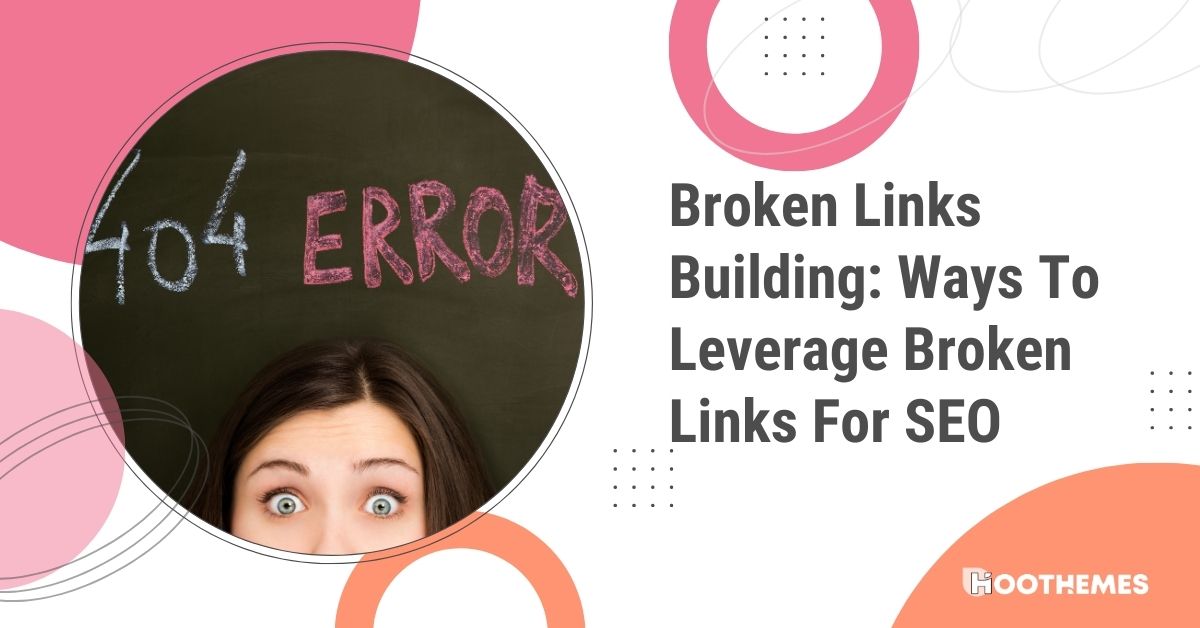There are a lot of moving parts to managing a website, and broken links are inevitable. You may think your administrative responsibilities stop once a page has gone live, but the internet is an ever-evolving space, and sometimes you just can’t have control over everything.
But worry not! There are some SEO tactics that can help you make the best out of your broken links.
Today, we’ll be outlining the five best ways to leverage broken links for the purpose of SEO. Read on to learn more about how you can leverage 404 pages into successful link building opportunities.
5 Ways To Leverage Broken Links For SEO
Broken links are a frustrating element of website building, in which a page previously linked no longer exists, causing web visitors to be redirected to a 404 page, leading to an increase in your bounce rate.
Although finding broken links that previously linked to valuable sources may be disheartening, try not to get too worried about this.
Broken links can be detrimental to SEO (‘search engine optimization’) as they can negatively affect your site user experience and Google rankings.
But there are actually ways to leverage broken links for SEO. So you may likely be able to find a positive way to spin this somewhat frustrating situation to your advantage.
1. Redirect 404 Pages on Your Website to Pages You’d Like to Rank
404 website errors present the perfect opportunity to capitalize on the link equity possessed by old links.
In other words, redirecting a 404 page that still ranks highly on SERPs (or ‘search engine results pages’) to another page on your website can actually help you retain that high ranking. That is if the new page is still contextually relevant to the search term.
Thinking smart is essential here, as the goal is to link to pages you want to rank but still ensure that you play by Google’s rules and consider the context.
Use keyword research to hyperlink to authoritative links that are relevant to your web page. A good way to gauge if an external link is worth adding to your site is to think critically about the value that it may add to your site’s existing content.
After all, the goal of your website is to provide valuable content for your target audience and boost your conversion rate. Linking to another high-ranking page will ensure you provide site visitors with the information they’re looking for, further supporting your site’s SEO.
Broken links can be both external and internal, and you can interchange how you redirect these links depending on where you’d like to send your traffic, according to rankings.
Although you don’t have to redirect 404s, it can be highly beneficial for boosting your site’s user experience and positioning you into being perceived as a reliable authority within your industry niche.
That said, you should only redirect a 404 if you find a good match, as you risk making your content irrelevant by adding new links just for the sake of ranking. Your priority should be ensuring the information on your page is concise. Quality over quantity always.
2. Remove Outdated Backlinks
When we talk about ‘authority’, the ultimate goal for all site managers is for their website to hold relevancy; having outdated content and backlinks can negatively affect this crucial quality.
Thankfully, removing outdated backlinks can help minimize the number of broken links on your page, ensuring your content is concise and holds value for site visitors and thus, for Google too.
Your backlink profile refers to the quantity and quality of links going in and out of your website. Relevant and high-ranking (or high-authority) links will ensure your backlink profile is authoritative, helping you rank higher on SERPs yourself.
You can use SEO tools to assess if backlinks that were previously on your page carried that much weight and relevance. If you find that the links weren’t adding too much ‘link juice’ to your site, then it’s generally best to remove the link entirely, just to ensure your website only holds the most relevant and up-to-date information.
Outdated backlinks don’t only have to be to pre-existing blogs but can be to discontinued products and information that may have since been developed or changed.
Google cares about your old and new content. Ensuring your older articles are still as relevant as they can be by checking for outdated backlinks, and other methods of updating your content, can significantly help your SEO.
3. Use Backlink Analytics Tools to Identify 404 Pages
So you’ve found all the 404 pages on your own website. Why not find some on other sites? But how exactly does this benefit you?
If you’re able to find 404 pages on high-authority blogs that are relevant to your market niche, then you may be able to capitalize off these 404 links yourself by suggesting to the bloggers that they link to your site content instead.
Of course, every blog likely has its fair share of 404 pages, and it’d take you ages if you were to contact every site. That’s why you should prioritize contacting the higher authority pages in your industry and niche, these being blogs that consistently rank well and are often linked to other organizations and enterprises within your industry.
Semrush’s Backlink Analytics tool is a great way to start doing this, as it will help you identify where the most opportunities lie. This software allows you to check when backlinks are deleted on any given domain, which can help you spot 404s.
The Backlink Analytics tool can also provide insights into the backlink profiles of your main competitors, making this software just as valuable for competitor analysis as it is for diversifying your link building opportunities.
When spotting trends in backlinks, you’ll be able to see which types of content are doing well in your industry and if any gaps need filling so that you can monetize your website and boost your income.
You can use this to your advantage, namely to start creating high-quality content that people are genuinely interested in, resulting in more backlinks to your page.
4. Recreate Content That is Being Linked To
While researching your competitors and those ranking highly in your niche, you may notice a pattern in the type of content that is consistently being linked to.
So why not use these findings to recreate this content so that you too can benefit from the topic’s high engagement? This isn’t to say that you should plagiarise or create a carbon copy of a page on another website. Just add your own angle to the content and see how you go.
Although creating informative and relevant content doesn’t guarantee backlinking, it’s a great start and can help you to stand out in your industry.
When other websites link to your content more frequently, Google rewards this by ranking you higher on SERPs for related search terms. And if you want to be a good digital samaritan, why not have your content linking to the pages it was inspired by?
After all, you’ll find that websites with high rankings are often linking to others as well, building a positive chain reaction that establishes excellent search engine results.
Archive.org’s WayBack Machine is a tool that makes it easier to find content that’s worth replicating. You can use your findings to create blogs and other forms of content that other figures in your industry may link to, which in time should lead to a healthier backlink profile and better rankings for your own domain.
5. Leverage The Broken Link Into a Blogger Relationship
Now we all know the frustration of stumbling upon 404 pages on your website. Imagine how helpful it would be for someone to alert you to all these error pages on your site before you see them yourself.
It would certainly cut your site administrative work clean in half. Well, why not offer this same courtesy to other blogs and websites within your industry?
While it may sound strange to notify someone that they need to edit their content, doing so with courtesy may actually help you build connections with other bloggers. That, and you may be able to use this interaction to offer your own links as a replacement for any 404 errors (see Point 3!).
This interaction could be motivated through an exchange too. For example, if you have included an external link to an authoritative site and then notice a 404 page on that same domain, making the site managers aware of this error could be a great opportunity to also let them know you linked to their other content.
There’s nothing better than having symbiotic relationships with other high-ranking sites in and around your industry niche.
We won’t deny that building relationships with bloggers can be challenging. Even so, it can be so gratifying when it goes well and can lead to collaborations alongside expanding your network.
Conclusion
The above five tips should help you make the most of your broken links, resulting in better rankings and higher domain authority in the long term. And remember, although having a few broken links across your website isn’t the end of the world, it’s best to keep them to a minimum.
Using business analytics tools will help you spot inactive links whilst also providing insights into popular backlinking trends in your industry. Be sure to analyze your competitors as well as industry blogs to identify any opportunities for providing your own site visitors with valuable content.
Additionally, you can use broken links on other blogs to your advantage, putting forward your own relevant content as a replacement for any 404 link errors.
Improving your SEO rankings can feel like an uphill battle at times. But rest assured, dedicating time to checking on your links and keeping your site updated with relevant information can help you stay on top of SERPs and at the head of your industry.





